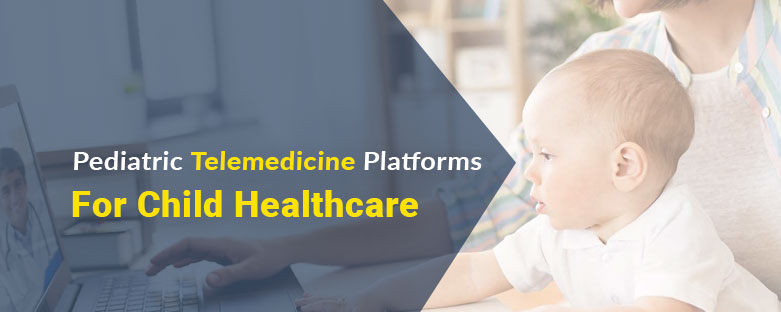Pediatric Telemedicine Platforms for child healthcare
Paediatricians can use Pediatric Telemedicine Platforms for child healthcare. It is possible to use telemedicine for tele-education, teleconsultation, telepractice and tale research.
Tele-education can be delivered via live interactive AV links, live video streaming, and viewing of stored educational material.
Tele-education programs allow physicians to stay current, travel less often for continuing medical education (CME), obtain free CME, foster relationships between academic and community-based physicians, and establish widespread peer groups to learn from each other and from academicians.
For young patients located outside who are in need of specialized pediatric care, the telemedicine brings world-class physicians close to home.
Pediatric Care thorough Pediatric Telemedicine Platforms
The Pediatric Telemedicine Platforms, through videoconferencing and store and forward technologies:
- Provides outpatient visits and access to highly skilled pediatric specialists in rural and outreach communities.
- Allows us to consistently meet urgent, emergent, and scheduled outpatient needs of young patients regionally and around the world.
- Provides online education and training to nurses and physicians in community hospitals.
What makes a good telemedicine pediatric application?
- Pediatric Telemedicine providers should be qualified in child care. Children are not small adults.
- Telehealth providers should have the experience and training needed to know how to safely and correctly diagnose and treat your child’s condition.
- Telemedicine Pediatric Applications do not replace your paediatrician. Good telehealth services work WITH your paediatrician. Your paediatrician may be the one seeing your child using telehealth, or he or she may have referred your child for a telehealth service. But, no telehealth service can take the place of your paediatrician—your medical home—who truly knows your child.
- The telehealth visit has to be SECURE and PRIVATE. The connection must be secure when connecting to your Provider. Both the patient and the telehealth provider should be in a private area so that people who aren’t supposed to be a part of the visit cannot see or hear anything that they shouldn’t.
- A responsible adult should be present with your child during the telehealth visit. Except in special situations where your child can legally consent to his or her own care, a responsible adult such as a parent, legal guardian, school nurse, paediatrician, or other healthcare providers should always be with your child during the telehealth service.
- Telehealth providers should follow up with you and your paediatrician. After the telehealth visit is over, the telehealth provider should send your paediatrician information about the visit, including any necessary follow-up. If you are unsure whether the telehealth provider has your paediatrician’s fax number or other contact information, you should have that information available and request that documentation about the visit be sent promptly to your paediatrician.
- The tools used should work for children. Some telehealth services use special cameras and other devices, like blood pressure cuffs, stethoscopes, and pulse oximeters, to help examine your child. These tools should be the correct size for your child and should be proven effective for examining children.
- Telehealth providers should carry out necessary tests and exams. Many telehealth tools are available to allow for a detailed examination of your child from a distance. These tools, such as otoscopes to look in your child’s ear, blood pressure cuffs, and pulse oximeters, can be used in a variety of settings—including the home—but their appropriate use requires training and practice.
- Before a telehealth provider who has never examined your child before gives your child antibiotics for an ear infection, he or she should use an otoscope to look in Your child’s ear — like as an in-person visiting provider would.
- Before the telehealth provider treats your child for a urinary tract infection, your child’s urine should be tested—as it would be in person.
- Using telehealth is not an excuse for not doing all the right tests and examinations before treatment. See the AAP-endorsed Operating Procedures for Pediatric Telehealth for more information.
- Telehealth providers should have clear guidance on when a virtual visit should be converted to a face-to-face visit. Sometimes a telehealth provider may determine that your child needs a more thorough examination, or is too sick to be cared for through telehealth after the telehealth visit has already started. In that case, telehealth providers should know when and how to refer your child to the most appropriate healthcare facility.
Top Telehealth Tips for Pediatricians
- Review Pediatric Telehealth best practices and resources
- Start off with a strong foundation. Many pediatric and telehealth organizations have already begun compiling resources, guidelines and research on pediatric use of telemedicine. Whatever your telehealth use case is, spend some time delving into the best practices and wrapping your head around how you can best integrate telemedicine into your PCMH
- Consider starting with common, simple-to-diagnose conditions
- Start with common medical problems that are often already diagnosed by the patients based on a picture or phone call. For example, a visit to telemedicine video can provide you with plenty of information to diagnose common rashes (diaper rash, tinea corporis) or to prescribe conjunctivitis antibiotics.
- You may also use telehealth video visits to easily refill prescriptions for patients, or have follow-ups for patients you have recently seen in-office.
- Research your pediatric telehealth reimbursement guidelines
- Have you heard of a telehealth parity law? Are you planning to seek reimbursement for telehealth visits through Medicare or private insurance companies?
- Find a telehealth software provider that makes family management easy
- Pediatric telehealth can be a perfect way to place parents in charge of the health care of their families. When you sign on with a telehealth software vendor, ask about what the user experience is like for families. Are parents can add their children as separate patients, who linked to their own account? Will they have access to records from the visit?





Your article helped me a lot, is there any more related content? Thanks!